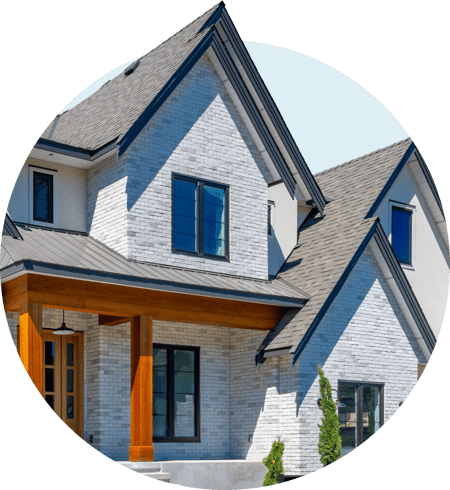The Impact of Rising Interest Rates on Roofing Material Prices
February , 2024 | 6 min. read
By Mitch Owens

In the ever-changing economic landscape of America, homeowners often face the challenge of navigating fluctuating material costs, particularly in the realm of home renovation projects. With interest rates playing a pivotal role in influencing market dynamics, the impact on material prices can be significant, presenting both opportunities and obstacles for those looking to enhance their homes. What’s the fun in that?
At RoofCrafters, we believe that understanding how to effectively manage high material costs amidst rising interest rates is of the utmost importance for homeowners seeking to begin their roofing projects, and we want you to be as educated (and frugal) as possible!
Knowledge is power, and if you’re due for a roof repair or replacement, and you’re concerned about the effects rising interest rates may have on your material prices, you’re in the right place. So, take a deep breath, and stick around to learn if and why roofing material costs rise with interest rates, and how you should deal with it, to put it simply. Let’s get started!
Do Roofing Material Costs Go Up When Interest Rates Rise?

So, what's the verdict? Roofing material costs can be influenced by changes in interest rates, although the relationship may not always be direct or immediate. Here are 4 ways how interest rates can impact roofing material costs:
Construction activity: When interest rates rise, borrowing costs for construction projects increase. This can lead to a decrease in construction activity, including roofing projects. If demand for roofing materials declines, suppliers may reduce prices to stimulate sales.
Manufacturing costs: Higher interest rates can increase the cost of financing for manufacturers. This can lead to higher production costs, including raw materials, labor, and transportation. As a result, manufacturers may pass these increased costs onto consumers, leading to higher prices for roofing materials.
Housing market: Interest rates can influence the housing market's health. When interest rates rise, it can make mortgages more expensive, potentially reducing home sales and construction activity. A slowdown in the housing market may decrease demand for roofing materials, leading to lower prices.
Inflation: Rising interest rates can be a response to higher inflation expectations. Inflation can increase the cost of materials, labor, and other inputs used in roofing production. As a result, roofing material costs may rise to reflect these increased costs.
So, while there may be a correlation between interest rates and roofing material costs, other factors such as market demand, supply chain disruptions, and regulatory changes can also play significant roles in determining prices.
Why Do Roofing Material Costs Rise with High-Interest Rates?

Why does this happen? Roofing material costs can rise with high interest rates due to several interconnected factors:
Decreased demand for housing: High-interest rates typically lead to higher mortgage rates, making borrowing more expensive for homebuyers. As a result, fewer people may be able to afford new homes or renovations, leading to decreased demand for roofing materials. With lower demand, suppliers may increase prices to maintain profitability.
Reduced construction activity: High-interest rates can deter individuals and businesses from undertaking construction projects, including roofing repairs or replacements. This decrease in construction activity can lead to a surplus of roofing materials in the market, prompting suppliers to raise prices to offset reduced demand.
Increased production costs: Manufacturers often rely on borrowing to finance operations, including raw material purchases, equipment acquisition, and facility expansions. When interest rates are high, borrowing becomes more expensive, leading to increased production costs. These higher costs are typically passed on to consumers in the form of higher prices for roofing materials.
Inflationary pressures: High interest rates may be implemented by central banks to control inflation. However, if inflation persists despite rate hikes, it can drive up the prices of goods and services, including roofing materials. Suppliers may raise prices to compensate for increased input costs, such as labor, transportation, and raw materials.
Supply chain disruptions: High interest rates can impact global economic conditions, leading to currency fluctuations, trade imbalances, and supply chain disruptions. These disruptions can affect the availability and cost of roofing materials, contributing to price increases.
Wow, the more you know! Overall, the relationship between high interest rates and rising roofing material costs is complex and influenced by various economic factors. While interest rates are a significant factor, other considerations such as market demand, inflation, production costs, and supply chain dynamics also play crucial roles in determining pricing trends.
How Should I Deal With High Roofing Prices Due to Rising Interest Rates?

Dealing with high material costs due to interest rates can be challenging for homeowners, but there are several strategies they can consider to mitigate the impact. Firstly, you should research current material prices and factor in potential increases due to rising interest rates when budgeting for home improvement projects. Having a clear understanding of the costs involved can help homeowners plan and save accordingly.
If possible, you could choose to delay your roofing project during periods of high material costs. Waiting for interest rates to decrease or for material prices to stabilize can help you save money in the long run. You can also explore financing options such as home equity loans or lines of credit to fund renovation projects if delaying your project isn’t in the cards. While interest rates may be higher during periods of economic tightening, locking in a fixed-rate loan can provide stability and predictability in monthly payments.
You can also consider negotiating with contractors to try to secure lower prices or discounts on materials and labor. Contractors may be willing to work with homeowners to find cost-effective solutions or adjust project timelines to accommodate budget constraints. When it comes to materials, you may be able to achieve similar aesthetic or functional outcomes by using alternative materials that are more affordable. Exploring different roofing materials or construction methods can help homeowners find cost-effective solutions without sacrificing quality.
As always, you should obtain quotes from multiple contractors and suppliers to compare prices and negotiate the best deal. Shopping around can help homeowners identify competitive pricing and ensure they're getting the best value for their investment.
Lastly, investing in energy-efficient upgrades such as insulation, windows, or roofing materials can help homeowners reduce long-term energy costs and offset the impact of high material prices. These upgrades may also qualify for tax incentives or rebates, providing additional savings.
Navigating High Material Costs Amidst Rising Interest Rates
While high material costs due to interest rates can present challenges for homeowners, proactive planning and strategic decision-making can help mitigate the impact. By researching current prices, budgeting effectively, exploring financing options, negotiating with contractors, considering alternative materials, investing in energy efficiency, and seeking multiple quotes, homeowners can navigate the complexities of the market and make informed choices about their home improvement projects.
Despite economic fluctuations, homeowners have the opportunity to achieve their renovation goals while managing costs and maximizing the value of their investments. With careful consideration and prudent decision-making, homeowners can adapt to changing market conditions and successfully complete their projects, enhancing the comfort, functionality, and value of their homes for years to come.
To take the first step towards a successful roofing project, be sure to hit the “Schedule an Inspection” button below, and begin your seamless assessment of your current roofing needs. With Roofcrafters' expertise and personalized service, you can confidently begin your next roofing project, knowing you’re in capable hands!
My name is Mitch, and I have over 10 years of roofing experience. I enjoy my career in the service industry because I love helping others take care of their homes and businesses. With over 10 years in the roofing industry, my success comes from my honesty and integrity during my roof inspections. I do my best to listen to the needs of my clients and strive to provide an awesome client experience.



